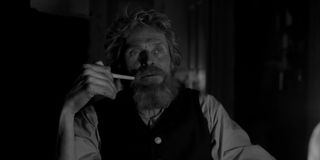The Lighthouse’s Robert Eggers Explains Why It Needed To Be Black And White

Robert Eggers made a serious splash with his directorial debut The Witch. The 2015 period horror piece was a critical and box office success, showing a New England family in the 1960s as supernatural forces slowly pick them off. The Witch has already become a modern classic for the genre, and all eyes have been on what he'll bring to theaters next. Luckily that wait is almost over, as Eggers' sophomore effort The Lighthouse will hit theaters shortly. The upcoming horror movie is in black and white, and the filmmaker recently explained what went into that thought process.
Robert Eggers recently appeared on our ReelBlend podcast, where he discussed his career, and in particular The Lighthouse. The black and white drama has been getting a ton of buzz from its early screenings on the festival circuit, and will get its wide theatrical release in a matter of weeks. Eggers opened up to the Reelblend hosts about the decision to go black and white for the highly anticipated drama. Specifically, the older type of film that he used. As he put it:
The blacks sort of bottom out suddenly in a way that’s very satisfying as a nice microcontrast and toothy grain. And it is kind of flat and primitive, but in a way that helps the crusty, dusty rusty, musty, atmosphere of the movie. And communicates the bleakness and austerity of their lifestyle and this island much better than if we’d shot digital with color.
The Lighthouse clearly has a visual language, and the trailers alone tease a movie unlike something we've seen before. It's shot in a square format, rather than the wide screen that audiences have become accustomed to. What's more, the grainy film helps add to the unsettling, grimy, and deserted setting of the movie. Willem Dafoe and Robert Pattinson's characters are trapped alone with each other, and its a dark existence... literally.
Related: The Lighthouse's Robert Pattinson Explains His Trick To Vomit Before Emotional Takes
You can hear Robert Eggers' full appearance on ReelBlend below, and be sure to subscribe to the podcast to stay up to date with all the exciting interviews ahead.
Powered by RedCircle
Later in his conversation with ReelBlend hosts Sean O'Connell, Jake Hamilton, and Kevin McCarthy, Robert Eggers went on to explain how the black and white nature of The Lighthouse ultimately helped bring the movie to life. Specifically when it was related to the characters' housing, which was far less bleak in full color. As he put it:
The interior of the keeper’s lodge was kind of nice looking. If you cleaned it up a bit, you’d want to live there. It could be a double RL photo shoot location. And his olive oil-skin jacket, you can probably buy something like that at Philson. So having it be black and white communicates the misery of the world.
It looks like The Lighthouse's black and white film was rather essential to crafting the movie's signature tone. Because without it, the remote existence of the two protagonists wouldn't be the same. The movie would have been less unnerving, making the characters' descent into chaos less emotionally effective.
CINEMABLEND NEWSLETTER
Your Daily Blend of Entertainment News
Color has been used very methodically in both of Robert Eggers' films so far. The Witch used a muted tone, highlighting the drab time setting of the movie, and the family's dark fate. The Witch is a sensory experience, with the visuals and sound helping to move the story forward.
Audiences will able to judge for themselves when The Lighthouse arrives in theaters on October 18th. In the meantime, check out our 2019 release list to plan your next trip to the movies.

Corey was born and raised in New Jersey. Graduated with degrees theater and literature from Ramapo College of New Jersey. After working in administrative theater for a year in New York, he started as the Weekend Editor at CinemaBlend. He's since been able to work himself up to reviews, phoners, and press junkets-- and is now able to appear on camera with some of his favorite actors... just not as he would have predicted as a kid. He's particularly proud of covering horror franchises like Scream and Halloween, as well as movie musicals like West Side Story. Favorite interviews include Steven Spielberg, Spike Lee, Jamie Lee Curtis, and more.
Most Popular






